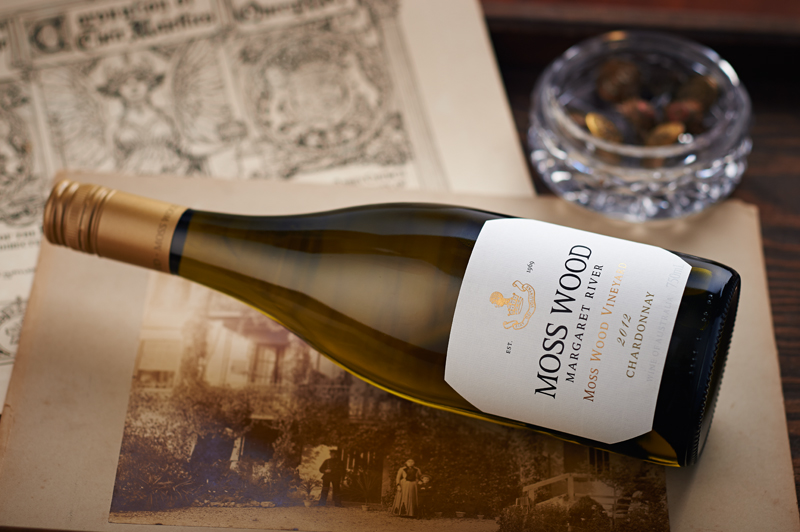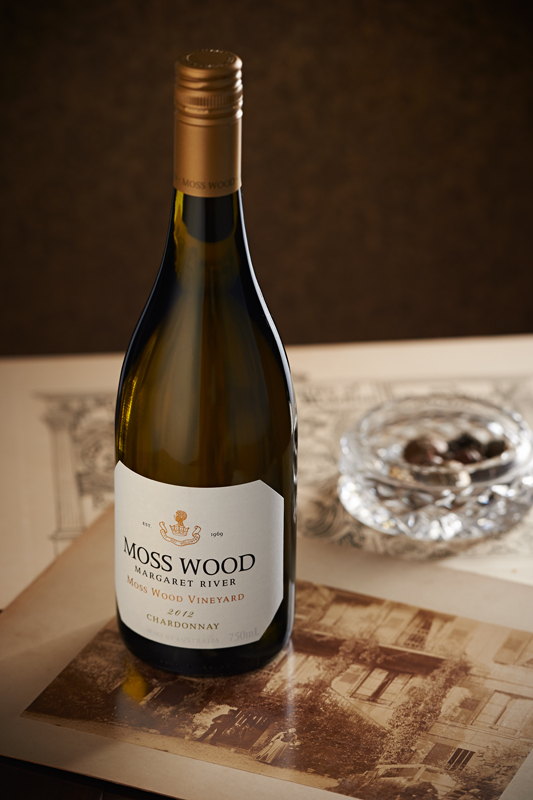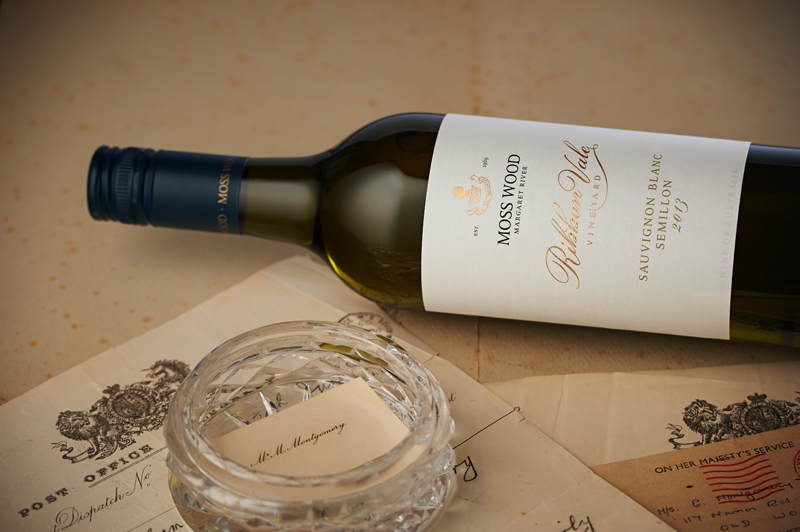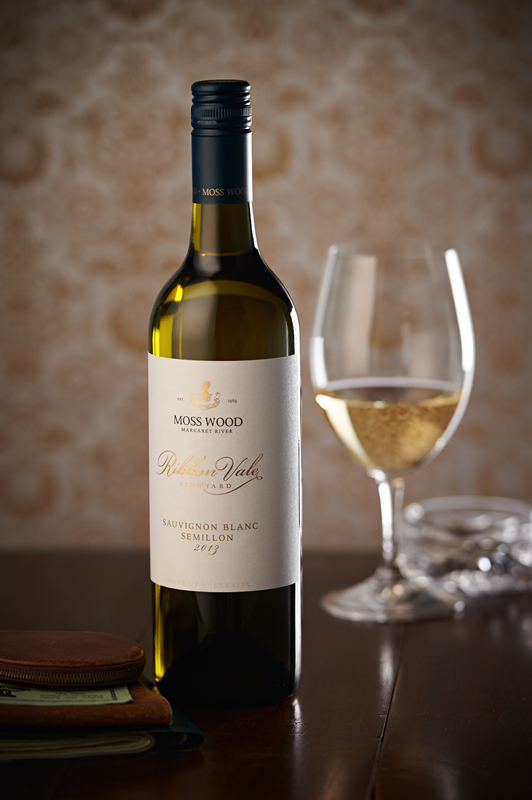Moss Wood Newsletter Spring News Issue #84, November 2013
Moss Wood 2012 Chardonnay
Moss Wood Ribbon Vale 2013 Sauvignon Blanc Semillon

Moss Wood 2012 Chardonnay
Vintage Notes
Those with an interest in history will know that Chardonnay has been part of the Margaret River winemaking landscape since the 1980 vintage. It was from that year that Leeuwin Estate, who released the first of their legendary Art Series wines, and Moss Wood, introduced what has now become the most famous white wine from our region.
For the record, our actual first crop was in 1979, when we picked a few buckets of grapes but the quantity was unmanageably small, amounting to significantly less than one barrel, so the fruit was included in the 1979 Semillon. The variety had something of a slow start in Western Australia. Bill and Sandra Pannell always wanted to make Chardonnay and had specially saved one of the best spots on the Moss Wood property for it. However, the release of the planting material was careful and slow as per the fastidious Western Australian quarantine process, and it did not become available until 1976. Obviously by that time there had been 4 vintages of Cabernet Sauvignon, the fledgling industry was just beginning to hit its straps and winemakers were keen to get their hands on Chardonnay to see what they could do with it. It was a frustrating delay and everyone was genuinely excited when the opportunity came to make the first wine in 1980.
Initially, everything went absolutely according to plan. We had good Spring weather during ’79 and so the vines flowered well and produced a good crop. Again, those with an eye for history will know the 1980 vintage has gone down as one of the very great years, and not surprisingly, the new Chardonnay was a cracker. Even the most conservative farming-type was convinced it was all going to be easy-peasy from there on.
How wrong we were. The following 1980/81 growing season was an absolute shocker, with heavy storms bringing strong wind, rain and hail right through until December. Luckily, this has since proven to be a reasonably rare thing and the next such season didn’t come through until the Spring of 1996. Regardless, the damage to the vineyards, especially Chardonnay, was massive and came as a shock because, up to that point, Margaret River had been a fairly benign viticultural area.
Chardonnay, being an early variety was worst hit but worryingly, displayed symptoms much more severe than the other varieties, with significant leaf loss and worse still, abortion of the immature bunches. We estimated the crop loss for the 1981 Chardonnay to have been around 80%, so it was a real blow.
Having worked our way through this problem, the year 1981 continued to haunt us by producing a severe frost in mid-October, another first in the viticultural memory. By virtue of its location at the bottom of our slope, the Chardonnay was completely covered, burning almost all the shoots and therefore the crop for the 1982 vintage.
These setbacks sent us looking for expert advice about how we might deal with these issues in future. In a sense, frost was the easy one because careful monitoring of the weather will give warning of an impending event and there are various ways to ameliorate the cold. For what it’s worth, we have since deployed diesel-burning
frost pots on chilly nights. Luckily, including the 1981 event, there have only been 3 of them.
Stormy weather has presented a different challenge, although solutions exist. Keeping the wind off the vineyards meant building wind breaks, either by special constructions or planting trees, or, for new vineyards, locating them where they are in the lee of the wind. This has a downside because trees provide an ideal shelter for birds near their food source. Here we see one of the amusing twists in agriculture because solving one problem introduces another.
If vineyards are planted close to shelter, unless bird nets are applied, losses to birds over a decade are likely to be greater than those caused by wind and hail!
Hail storms can be negated by covering the vineyard with hail netting, something used quite widely in fruit orchards. However, it’s very expensive and has not been used in Margaret River. Although hail will damage vines, the probability of very heavy losses is relatively low and means the use of nets is not economic.
The summary of what we’ve learned about these problems is simple. If we receive regular cool, wet and windy conditions through September and October, Chardonnay struggles with both the cold and the physical damage. The former suppresses the vine’s vigour and the latter introduces the risk of secondary infection by fungi. The whole thing is compounded if we also receive hail.
We can minimise the loss of crop if weather conditions allow us to make a careful application of the correct fungicide to control fungal disease. However, while it’s stating the obvious, there’s not much we can do about cool weather.
It has to be said that variable weather is not uncommon during our Spring and it’s rare to have a season where the vines don’t experience some adverse conditions. Fortunately, we can minimise the impact in an “average” year, now that we know the key treatments.
This brings us to the 2012 vintage and despite everything we’ve described above, from 2006 to 2013 we had an unprecedented run of favourable years. Even the big hailstorm of December last year failed to upset the Chardonnay. This means the 2012 vintage is the 6th in a row where we produced average or higher crop levels. Quite why this has happened is difficult to say but we hope it reflects that we better understand how to deal with the conditions and the result is more consistent yields.
Regretfully, it will not continue into 2014, where cold, windy conditions lasted through till the end of October 2013 and the flowering on the Chardonnay is very poor. Still, with 7 good years in a row, we don’t really have much to complain about!
Returning to 2012, there were definitely no excuses because we had just about everything in our favour. The calendar year had slightly above average rainfall of 1048mm but usefully for us, 52mm, 49mm and 27mm fell in October, November and December, respectively. The timing was perfect, avoiding the crucial stages in flowering. On cue, the weather turned warm and dry in January, the average temperature was 23.03°C, slightly more than 2° above average and only 2mm of rain fell. We recorded 53 hours above 33° C, plenty to ripen the fruit flavours, and the last 2 weeks gave us regular maxima in the mid-thirties culminating in the hottest day of the summer - 39° C on the 25th. Things then eased and we had 9mm rain of in the first week of February which signalled the end of hot Summer weather and we received only a further 12 hours above 33° C. All varieties were able to
proceed at a steady but leisurely
pace, to full ripeness.
For the technically minded, the median harvest date was 26th February, 4 days earlier than average but 112 days after flowering, so the actual ripening period was 2 days longer than average. The vines experienced 1028 hours in their preferred temperature range of 18-28° C, compared to the average of 906 hours. The warmish season is further confirmed because the total hours accumulated above 33° C was 79, compared to the average of 47. The yield figure suggests the warmth was a bonus because at 10.11 tonnes per hectare, 45% above the long term average of 6.99 tonnes per hectare, the vines needed all the warmth they could get to keep ripening on track. It also highlights how lucky we have been with the sequence of good years.
Finally, consistency of the vintage is confirmed by the ripeness of 13.3° Baume, almost exactly on the average of 13.2°.

Production Notes
Harvest Date: 26th Feb, 2012
Ripeness: 13.3° Baume
The production technique for the Chardonnay was typical Moss Wood. The fruit was hand-picked, placed in bins and delivered to the winery. Once there, the bins were emptied into the presses and the whole bunches were pressed and juice pumped to stainless steel tanks for settling. The free run and pressings fractions were kept separate. The former was settled for 48 hours then the clear juice was racked into another stainless steel tank and seeded with pure yeast culture for fermentation. The latter was fined to reducethe tannin content and then the clear juice was racked in readiness for inoculation with pure yeast culture.
Once fermentation was under way and proceeding normally, the juice was racked to small, French oak barrels, 50% of which were new. Temperatures were controlled by setting the air conditioning system as low as possible and chilling the barrel cellar right down – air temperature hovered around 8° C. The barrels themselves provide very good insulation, so fermentation will be much warmer and went through at around 20° C.
After primary fermentation was completed, the barrels were racked into stainless steel to equalise the blend and the wine was seeded for malolactic fermentation. While we like the characteristics of this secondary ferment and always try and promote it, we generally don’t have much success. Usually it will stop when about one third of the way through but for reasons best known to the malolactic bacteria, the 2012 wine went all the way to completion. This makes it the third of our Chardonnays to have done so, along with the 1984 and the 1997.
At the beginning of August 2013 the wine was racked from barrel and blended in stainless steel, in preparation for bottling. Fining trials were carried out and the decision was made to fine with bentonite for protein stability and also with isinglass which enhanced the tannin balance. The wine was then sterile filtered and bottled.
Tasting Notes
Colour:
Medium to deep straw; bright condition.
Nose:
This combines all that is interesting about Chardonnay – generous stone fruits of apricot and peach and blossom and frangipani-like notes. The background array includes marmalade, citrus rind and roast cashew. There is also great complexity derived from the caramel and butter notes of malolactic fermentation and
the subtle, spicy, charry oak.
Palate:
In line with the aromas, the palate delivers all that is exciting about the variety. Generous, full bodied and creamy mouth-feel; bright
acidity and round, soft tannin; all finished off by subtle, toasty oak notes.
Cellaring:
Even though this is a young wine it is generous and complex drinking already. However, with all its various components it will slowly become more complex over the next 10 to 15 years. For those who enjoy the Chardonnay when its bottle complexity is most dominant, we recommend cellaring for 20 years.

Moss Wood Ribbon Vale 2013 Sauvignon Blanc Semillon
Vintage Notes
After the lengthy history lesson and commentary about the impact of springtime weather on the Chardonnay, we can commence this section by saying both Sauvignon Blanc and Semillon cope much better than their more illustrious cousin. While they will show similar symptoms to Chardonnay, they are never as bad. Perhaps this is because both are natives of the maritime climate of the Bordeaux region in France and have evolved with a tolerance to our conditions. Or perhaps it’s just the simple point that they both go through a later budburst and therefore miss out on more of the crook weather. We don’t really know.
All of the above is true until we confront a season like 2012/13. The start was literally perfect, perhaps because Mother Nature wanted to lull us into a false sense of security. Take the rainfall, for example. Although calendar year 2012 was slightly below average, with 947mm recorded compared to an average of 1000mm, we received excellent Spring rain. September received a whopping 143mm, then October and November received 33mm and 60mm respectively and the timing was such that none of it interfered with flowering.
So where is the problem, readers may ask? All was well until the last few days of Spring when arrived a monumental storm, the likes of which hadn’t reared its ugly head since 1996. For those who like to think about weather cycles there was a nice consistency about this because the previous such event had occurred 16 years earlier, in 1980. And then, just for further amusement, although there were no vineyards in Margaret River, the local farmers reckoned the previous such event had occurred on 1964. From our point of view, if these sorts of storms do come round in 16 year cycles, 2028 will be plenty soon enough, thanks very much.
The other curiosity associated with last year’s event was it did more damage to the Bordeaux varieties than Chardonnay. Yield for Sauvignon Blanc was 8.69 tonnes per hectare, down 23% on its long term average of 11.3. Similarly, Semillon yielded 7.88 tonnes per hectare, down 30% on its average of 11.2. Chardonnay on the other hand completely stumped us. Despite showing obvious marking and pitting from hail, it produced 8.65 tonnes per hectare, some 24% ABOVE its long term average.
After bashing us up, the season then settled down and we had very reasonable conditions through to harvest. January was especially pleasant, with average temperatures and little extreme heat. February changed this and produced an average temperature of 22.15° C, which is 0.94° above average and included the hottest day of the summer on the 12th, when the mercury reached 39.5° C.
This combined with the lighter crops brought ripening on quite quickly. The Sauvignon Blanc was picked on 16th February, 12 days earlier than average and the Semillon was picked on 28th February, 16 days earlier. Ripeness was 12° Baume in Sauvignon Blanc and 14.1° in Semillon. The former was almost exactly on the average of 12.2° but Semillon was nice and ripe at 1° above.
After all that had gone on earlier in the process, we were relieved to get both the varieties where we like them – the Sauvignon Blanc at lower ripeness to provide juiciness and freshness and ripe Semillon to provide complexity and richness on the palate.

Production Notes
Median Harvest Date and Ripeness:
Sauvignon Blanc: 16th February 2013; 12.0° Baume
Semillon: 28th February 2013; 14.1° Baume
Our technique is the same for both Sauvignon Blanc and Semillon - all the fruit is handpicked, placed in bins and delivered to the winery. There the fruit is destemmed and chilled then put into the press. The free run and pressings fractions are kept separate. Both are chilled and settledin stainless steel tanks but the pressings are also fined to reduce tannin.
After cold settling for 48 hours, the juices were racked off the lees and allowed to warm up to 18°C and then seeded with pure yeast culture. Fermentation then proceeded through to dryness, controlled initially to 15° C for Sauvignon Blanc and 18° C for Semillon. Once fermentation is completed, the new wines were racked to stainless steel and adjusted for acidity and sulphur dioxide.
After analyses were completed and the quality of both components was confirmed, the two varieties were combined for the first time. The final contributions were Sauvignon Blanc 51% and Semillon 49%.
In an extension of our technique, designed to improve the complexity and palate weight of our style, just over 40% of the blended wine was then put to French oak barrels. After 3 months the palate had developed greater richness and the barrels had provided interesting mineral notes that highlighted the green and cedary fruit aromas of the Sauvignon Blanc. We were concerned not to compromise overall freshness and at the end of October the different components were racked and combined for the final time.
Fining trials were carried out and bentonite was used for protein stability. No other agent gave any improvement. After fining, the wine was sterile filtered and bottled.
Tasting Notes
Colour and condition:
Medium straw colour; bright condition.
Nose:
Bright, fresh Sauvignon Blanc aromas of leaf, grass and guava; these are enhanced by a touch of cedar from oak barrels; ripe Semillon characters of lemon sherbet, fig and honey fill the background.
Palate:
This is immediately generous and round, with full body and quite luxurious; acidity is still fresh, giving the wine crisp, grassy and
cumquat-like fruit flavours that lead to a mineral finish, enhanced by delicate oak flavours.
Cellaring:
The wine is delicious to drink now, with its full body and generous mouthfeel but has good acidity underneath. Over the next 10 years it will gradually build classic Semillon aged characters like toast and butter. For those who enjoy crisp, bright fruit characters, it is best drunk over the next 2 to 3 years. Those who enjoy the bottle bouquet and have the patience should keep it for at least a decade.
Order
OUR WINES:
Contact
MOSS WOOD:
Location: 926 Metricup Road, Wilyabrup WA
Postal: PO Box 225, Cowaramup WA 6284
Phone: +61 8 9755 6266
Fax: +61 8 9755 6303
Follow us on
SOCIAL MEDIA:
